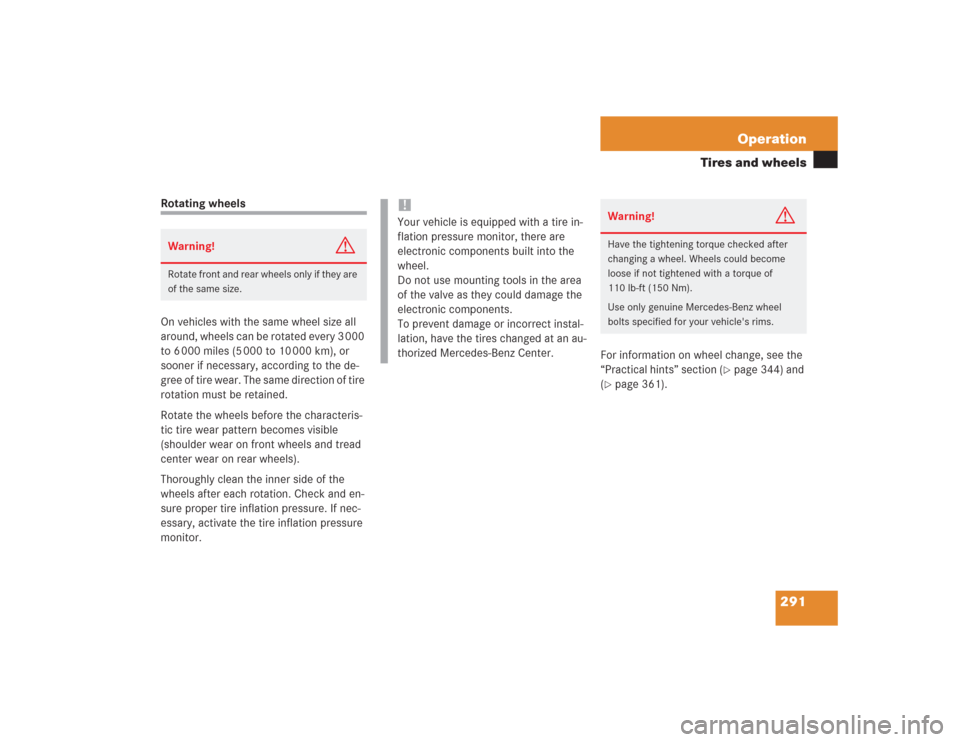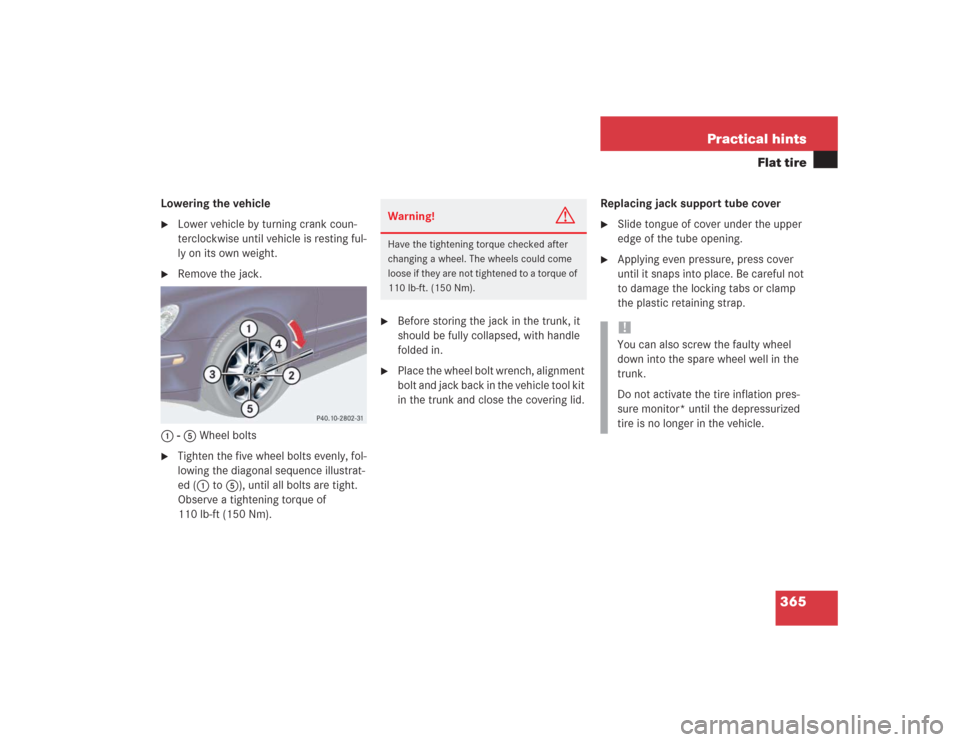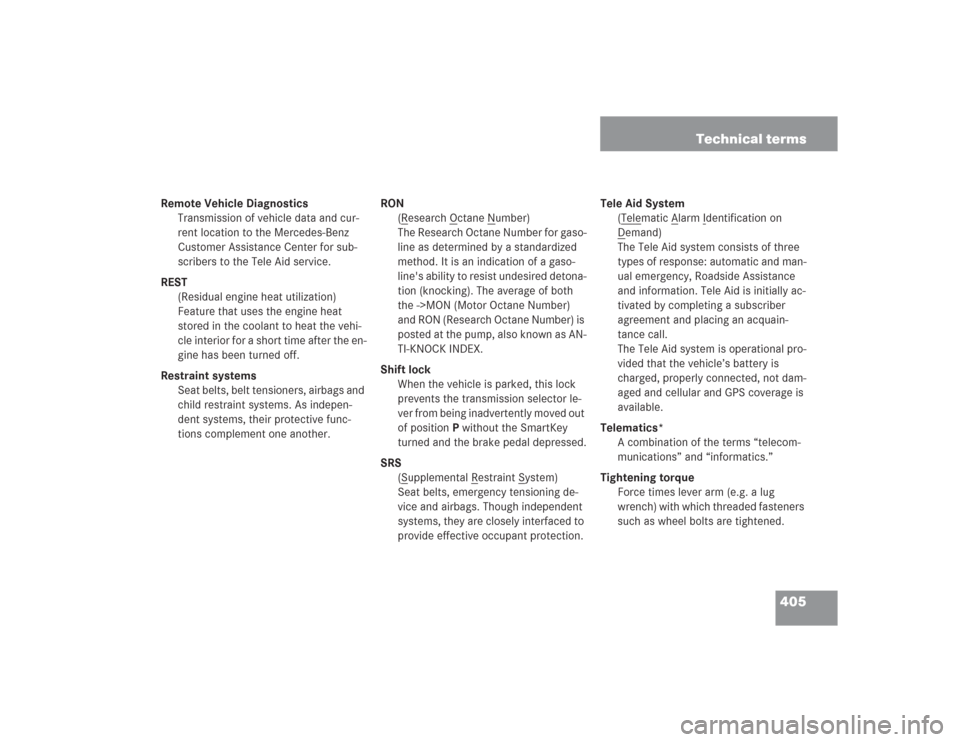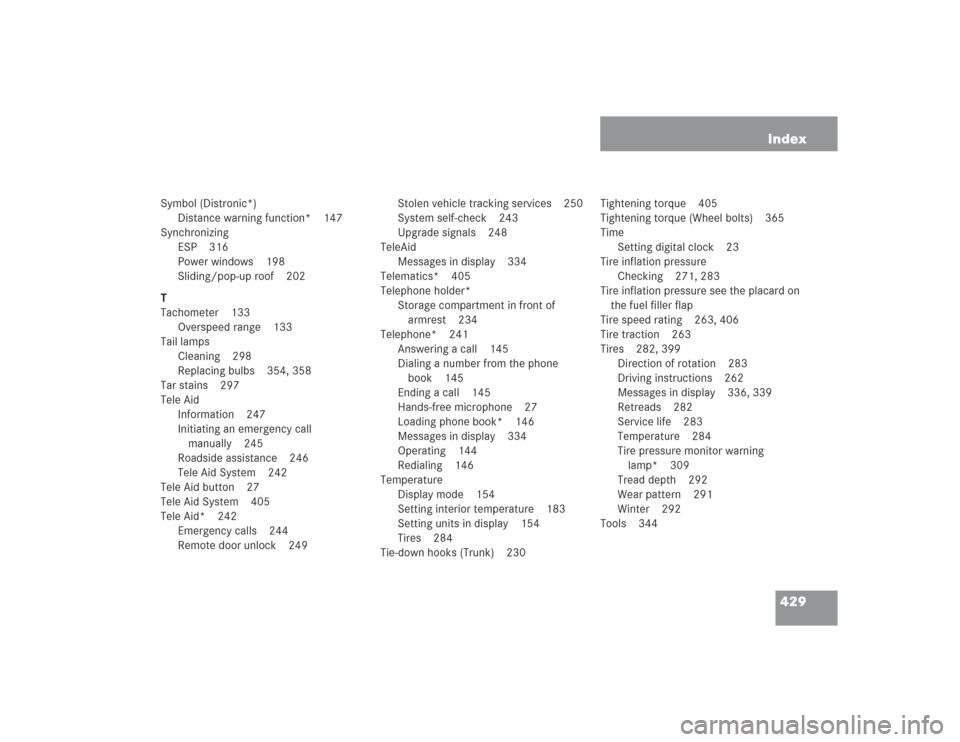Page 292 of 435

291 Operation
Tires and wheels
Rotating wheels
On vehicles with the same wheel size all
around, wheels can be rotated every 3 000
to 6 000 miles (5 000 to 10 000 km), or
sooner if necessary, according to the de-
gree of tire wear. The same direction of tire
rotation must be retained.
Rotate the wheels before the characteris-
tic tire wear pattern becomes visible
(shoulder wear on front wheels and tread
center wear on rear wheels).
Thoroughly clean the inner side of the
wheels after each rotation. Check and en-
sure proper tire inflation pressure. If nec-
essary, activate the tire inflation pressure
monitor.For information on wheel change, see the
“Practical hints” section (
�page 344) and
(
�page 361).
Warning!
G
Rotate front and rear wheels only if they are
of the same size.
!Your vehicle is equipped with a tire in-
flation pressure monitor, there are
electronic components built into the
wheel.
Do not use mounting tools in the area
of the valve as they could damage the
electronic components.
To prevent damage or incorrect instal-
lation, have the tires changed at an au-
thorized Mercedes-Benz Center.
Warning!
G
Have the tightening torque checked after
changing a wheel. Wheels could become
loose if not tightened with a torque of
110 lb-ft (150 Nm).
Use only genuine Mercedes-Benz wheel
bolts specified for your vehicle's rims.
Page 366 of 435

365 Practical hints
Flat tire
Lowering the vehicle�
Lower vehicle by turning crank coun-
terclockwise until vehicle is resting ful-
ly on its own weight.
�
Remove the jack.
1 - 5 Wheel bolts
�
Tighten the five wheel bolts evenly, fol-
lowing the diagonal sequence illustrat-
ed (1 to 5), until all bolts are tight.
Observe a tightening torque of
110 lb-ft (150 Nm).
�
Before storing the jack in the trunk, it
should be fully collapsed, with handle
folded in.
�
Place the wheel bolt wrench, alignment
bolt and jack back in the vehicle tool kit
in the trunk and close the covering lid.Replacing jack support tube cover
�
Slide tongue of cover under the upper
edge of the tube opening.
�
Applying even pressure, press cover
until it snaps into place. Be careful not
to damage the locking tabs or clamp
the plastic retaining strap.
Warning!
G
Have the tightening torque checked after
changing a wheel. The wheels could come
loose if they are not tightened to a torque of
110 lb-ft. (150 Nm).
!You can also screw the faulty wheel
down into the spare wheel well in the
trunk.
Do not activate the tire inflation pres-
sure monitor* until the depressurized
tire is no longer in the vehicle.
Page 406 of 435

405 Technical terms
Remote Vehicle Diagnostics
Transmission of vehicle data and cur-
rent location to the Mercedes-Benz
Customer Assistance Center for sub-
scribers to the Tele Aid service.
REST
(Residual engine heat utilization)
Feature that uses the engine heat
stored in the coolant to heat the vehi-
cle interior for a short time after the en-
gine has been turned off.
Restraint systems
Seat belts, belt tensioners, airbags and
child restraint systems. As indepen-
dent systems, their protective func-
tions complement one another.RON
(R
esearch O
ctane N
umber)
The Research Octane Number for gaso-
line as determined by a standardized
method. It is an indication of a gaso-
line's ability to resist undesired detona-
tion (knocking). The average of both
the ->MON (Motor Octane Number)
and RON (Research Octane Number) is
posted at the pump, also known as AN-
TI-KNOCK INDEX.
Shift lock
When the vehicle is parked, this lock
prevents the transmission selector le-
ver from being inadvertently moved out
of positionP without the SmartKey
turned and the brake pedal depressed.
SRS
(S
upplemental R
estraint S
ystem)
Seat belts, emergency tensioning de-
vice and airbags. Though independent
systems, they are closely interfaced to
provide effective occupant protection.Tele Aid System
(T
elematic A
larm I
dentification on
D
emand)
The Tele Aid system consists of three
types of response: automatic and man-
ual emergency, Roadside Assistance
and information. Tele Aid is initially ac-
tivated by completing a subscriber
agreement and placing an acquain-
tance call.
The Tele Aid system is operational pro-
vided that the vehicle’s battery is
charged, properly connected, not dam-
aged and cellular and GPS coverage is
available.
Telematics*
A combination of the terms “telecom-
munications” and “informatics.”
Tightening torque
Force times lever arm (e.g. a lug
wrench) with which threaded fasteners
such as wheel bolts are tightened.
Page 430 of 435

429 Index
Symbol (Distronic*)
Distance warning function* 147
Synchronizing
ESP 316
Power windows 198
Sliding/pop-up roof 202
T
Tachometer 133
Overspeed range 133
Tail lamps
Cleaning 298
Replacing bulbs 354, 358
Tar stains 297
Tele Aid
Information 247
Initiating an emergency call
manually 245
Roadside assistance 246
Tele Aid System 242
Tele Aid button 27
Tele Aid System 405
Tele Aid* 242
Emergency calls 244
Remote door unlock 249Stolen vehicle tracking services 250
System self-check 243
Upgrade signals 248
TeleAid
Messages in display 334
Telematics* 405
Telephone holder*
Storage compartment in front of
armrest 234
Telephone* 241
Answering a call 145
Dialing a number from the phone
book 145
Ending a call 145
Hands-free microphone 27
Loading phone book* 146
Messages in display 334
Operating 144
Redialing 146
Temperature
Display mode 154
Setting interior temperature 183
Setting units in display 154
Tires 284
Tie-down hooks (Trunk) 230Tightening torque 405
Tightening torque (Wheel bolts) 365
Time
Setting digital clock 23
Tire inflation pressure
Checking 271, 283
Tire inflation pressure see the placard on
the fuel filler flap
Tire speed rating 263, 406
Tire traction 263
Tires 282, 399
Direction of rotation 283
Driving instructions 262
Messages in display 336, 339
Retreads 282
Service life 283
Temperature 284
Tire pressure monitor warning
lamp* 309
Tread depth 292
Wear pattern 291
Winter 292
Tools 344